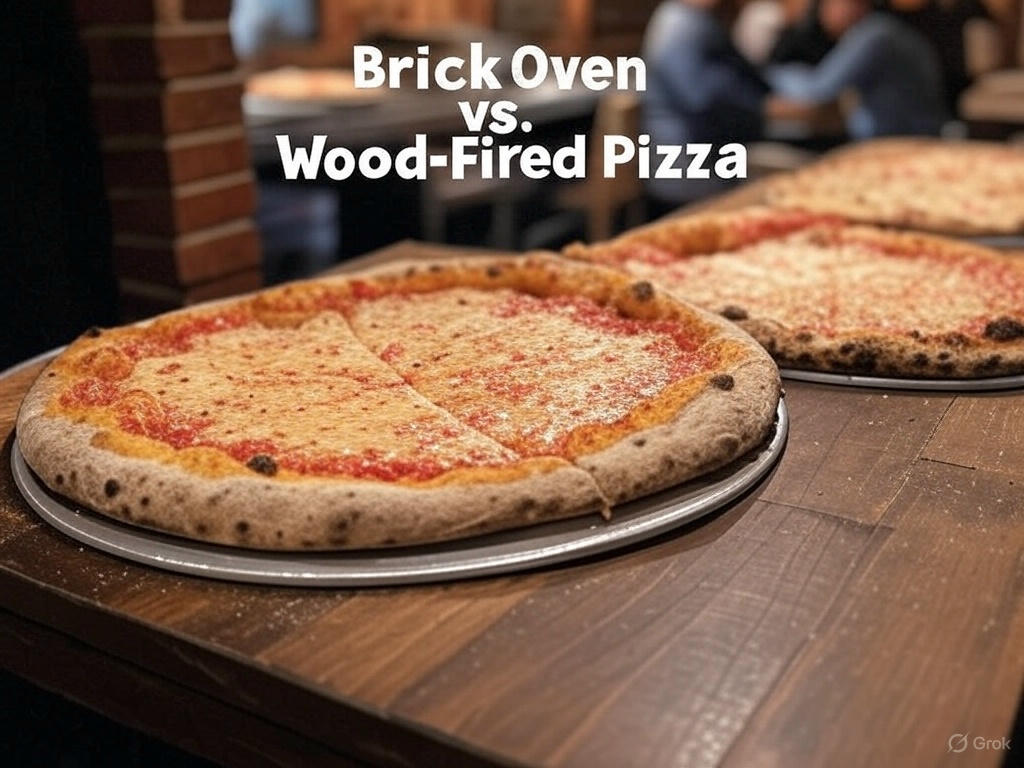Imagine sinking your teeth into a pizza with a perfectly crisp crust, gooey melted cheese, and a smoky hint that leaves you wondering: Is this from a brick oven or a wood-fired one? If you’ve ever debated brick oven pizza versus wood-fired pizza, you’re not alone.
These two iconic cooking methods produce delicious results, but they each bring unique qualities to the table. In this post, we’ll explore the differences between brick oven pizza and wood-fired pizza, from their cooking techniques to the flavors they deliver. By the end, you’ll know which might suit your taste buds best. Let’s get started!
What Is Brick Oven Pizza?
Brick oven pizza is cooked in an oven made of refractory bricks, designed to trap and radiate heat evenly. These ovens are like thermal powerhouses, soaking up warmth and distributing it consistently across the cooking surface. They can be fueled by gas, electricity, or even wood, maintaining temperatures between 600°F and 900°F. This steady heat creates a crust that’s slightly charred on the edges, chewy in the center, and crisp underneath.
What makes brick ovens special is their versatility. While some traditionalists prefer wood, modern brick ovens often use gas or electric heat for convenience without compromising quality. The result is a reliable, delicious pizza with balanced flavor and texture. Curious about how brick ovens work? It’s all about controlled, even cooking that delivers a consistent slice every time.
What Is Wood-Fired Pizza?
Wood-fired pizza is a nod to old-world tradition. These ovens rely solely on burning wood, which heats the oven and infuses the pizza with a signature smoky flavor. The fire generates intense, direct heat, often reaching 800°F to 1000°F. At these scorching temperatures, a pizza can cook in just 90 seconds, producing a crust that’s blistered, slightly charred, and full of character.
The charm of wood-fired pizza comes from its rustic nature. The type of wood—think oak, maple, or fruitwoods—can subtly alter the taste, adding depth to every bite. However, this method is less predictable than a brick oven. Flames shift, and heat varies, making each pizza a one-of-a-kind creation. If you’re after authentic wood-fired pizza or wondering about the , this technique offers a bold, smoky experience.
Key Differences Between Brick Oven and Wood-Fired Pizza
To help you compare brick oven pizza and wood-fired pizza, here’s a breakdown of their main differences:
| Factor | Brick Oven Pizza | Wood-Fired Pizza |
|---|---|---|
| Heat Source | Gas, electric, or wood | Only wood |
| Temperature | 600°F–900°F | 800°F–1000°F |
| Cooking Time | 2–5 minutes | ~90 seconds |
| Flavor | Even, slightly charred | Smoky, intense char |
| Consistency | More controlled | Varies with wood/flame |
Here’s what these differences mean:
- Heat Source: Brick ovens are flexible with fuel, while wood-fired ovens stick to wood for that authentic touch.
- Temperature: Wood-fired ovens run hotter, speeding up the cooking process.
- Cooking Time: Higher heat in wood-fired ovens means faster results—perfect for quick meals.
- Flavor: Brick oven pizzas offer a subtle char, while wood-fired pizzas pack a smoky punch.
- Consistency: Brick ovens provide predictability; wood-fired ovens embrace variability.
These distinctions explain why each method has its own fans. Still unsure about the difference between brick oven and wood-fired pizza? It’s all about fuel, heat, and taste!
Which One Is Better?
So, brick oven pizza or wood-fired pizza—which wins? It depends on what you love in a pizza. Here’s how to decide:
- Brick Oven Pizza: Ideal if you crave consistency and a crust that’s evenly baked with a gentle char. It’s great for those who want a dependable, delicious slice every time.
- Wood-Fired Pizza: Perfect if you’re drawn to bold, smoky flavors and enjoy a bit of rustic unpredictability. It’s a treat for adventurous eaters.
Pizza style matters too:
- Neapolitan pizza, with its thin, soft crust and blistered edges, shines in a wood-fired oven.
- New York-style pizza, with a thicker, crispier base, often pairs well with the controlled heat of a brick oven.
There’s no best oven for pizza—it’s about your preference. Why not try both? Visit a local pizzeria with a brick oven, then seek out a wood-fired spot and compare. Your taste buds will love the experiment!
Common Myths Debunked
Let’s bust some myths about brick oven pizza and wood-fired pizza:
Myth #1: All Wood-Fired Ovens Are Brick Ovens
Not true! While many wood-fired ovens use brick, they can also be made from metal or other materials. The key is the wood fuel, not the construction.
Myth #2: Brick Ovens Can’t Get as Hot as Wood-Fired Ovens
False. Brick ovens can hit the same high temperatures, especially when wood-fueled. The difference is in heat distribution—brick ovens spread it evenly, while wood-fired ovens focus intense, direct heat.
Clearing up these misconceptions helps you appreciate both methods even more.
Conclusion
In the showdown of brick oven vs. wood-fired pizza, there’s no single champion—just two fantastic options. Brick ovens offer consistency and a balanced bite, while wood-fired ovens deliver smoky, rustic flair. Whether you’re team even bake or team smoky char, both bring something special to the pizza party.
So, what’s your pick? Do you prefer the reliability of a brick oven or the bold taste of a wood-fired pie? Better yet, try both and decide for yourself! Head to a local pizzeria and taste the difference. And if you’re inspired to recreate the magic at home, check out our guide on . Pizza lovers unite—there’s no such thing as too much pie!

